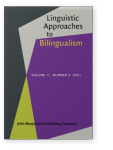Vol. 11:5 (2021) ► pp.640–668
What does and doesn’t affect L2 overt pronoun production
A Corpus Study of L1-English, L1-Korean, and L1-Mandarin L2 Speakers of Japanese
This study examined corpus data from learners of Japanese whose L1s are English, Korean, and Mandarin (as well as native-speaker Japanese controls), in order to investigate the effect of two separate (but sometimes conflated) potential influences on overt pronoun production in the L2: (i) whether or not the L1 is a topic-drop language (like Japanese), and (ii) the properties of overt pronouns in the L1 compared to those of Japanese. In order to investigate (i), the rate of overt pronoun use in topic/argument position for all three learner groups was tabulated and compared to that of native speakers. In order to investigate (ii), total rate of overt pronoun use in all positions was tabulated, as well as the type of case-/discourse-marking particles that accompanied overt pronouns in each learner group, compared to native speakers. Results show no influence of L1 topic-drop status, but some influence of L1 overt pronoun properties, in the form of (a) interactions between the morphosyntax of pronouns and broader DP/NP structure in the L1 and L2, and (b) shared discourse properties of the overt pronoun in the L1 and L2.
Article outline
- 1.Introduction
- 1.1L2 Acquisition of topic-drop languages: Previous studies
- 1.2Possible influences on overt pronoun production in L2 Japanese
- 1.2.1Topic-drop status: [EPP] feature on T
- 1.2.2Properties of overt pronouns: Frequency
- 1.2.3Properties of overt pronouns: Morphosyntax
- 2.Research questions
- 3.Methods
- 3.1Corpora & transcript selection
- 3.2Procedure & coding
- 4.Data analysis
- 4.1Quantitative analysis
- 4.2Qualitative analysis
- 4.3Summary of results
- 5.Discussion
- 5.1Possible influence of [EPP] feature
- 5.2Properties of overt pronouns in the L1: Overt pronoun frequency
- 5.3Properties of overt pronouns in the L1: Overt pronoun morphosyntax
- 5.4An unexpected finding: Overproduction of overt pronouns by L1-Korean speakers
- 5.5Limitations
- 6.Conclusion
- Notes
-
References
